Tethered to the southwestern tip of Korea, Jindo is the nation’s third-largest island, surrounded by hundreds of large and small islets. Squatting on the maritime route linking China and Japan, the island has a rich history that encompasses abundant harvests, folk music and rites, political exiles, and epic struggles.
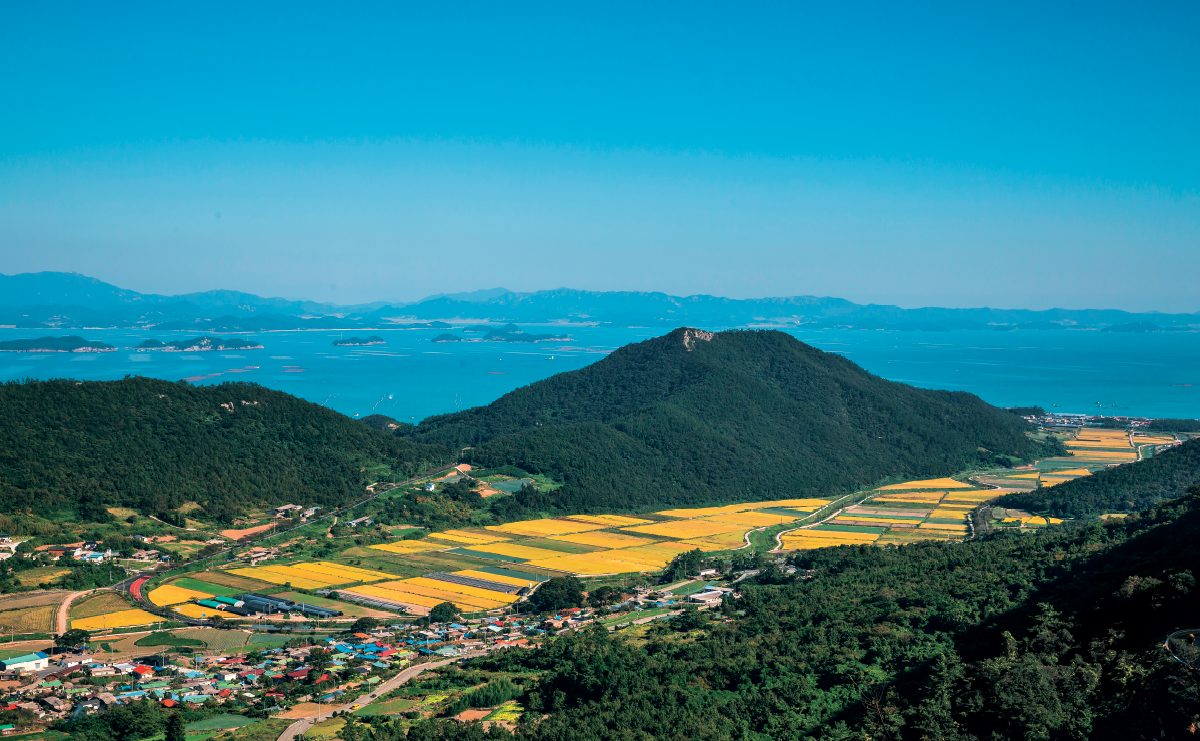
A view of Jindo, or Jin Island, looking down from Mt. Cheomchal. Low mountains shield golden fields against wind from the sea. Haenam County on the Korean peninsula can be seen across the sea.
On September 9, 1816, Basil Hall (1788–1844), captain of the British warship Lyra, climbed to the highest point on Sangjo Island off the coast of Jindo (or Jin Island) and gazed upon an archipelago of more than 100 islets. “A splendid view,” he exclaimed.
Today, Basil Hall Park near the Mt. Dori observatory on Jindo commemorates the British captain’s visit. If you arrive at Sebang Nakjo on the southwest coast and reach the observatory before the evening twilight, you will appreciate Hall’s description. The beauty seen from this spot is renowned, and fortunate visitors will see a myriad of islets dotting the sea like black birds on the water to the left of the setting sun as it dyes the clouds pink. They form the Jodo Gundo (Archipelago of Bird Islands) that once bedazzled Hall and his crew.
The ship commander had been part of a British mission to increase trade with China when he received an order to explore the west coast of Joseon, today’s Korea. He recorded the details of his trip in his book “A Voyage of Discovery to the West Coast of Corea and the Great Loo-Choo Island,” published in 1818, which informed the world that Jindo was a place accessible to ships. This was half a century before Korean ports were officially opened to Japan and subsequently Western powers. It is said that Britain later asked the Joseon court to lease Jindo and the Archipelago of Bird Islands. Jindo locals believe that had their island been loaned to Britain it would have become a teeming entrepôt in the same way as Hong Kong.
While Jindo missed the possibility of robust trade and commerce, it did become a crucible for foreign and native elements to intertwine and flourish. But Jindo’s location also lent itself to become a famous place of bloodshed and despair. The island’s seat in the top rung of historic episodes belies its position at the bottom tier of the Korean peninsula.
Fertile and Musical
Jindo covers about 360 square kilometers, which is some 60 percent the size of Seoul proper. A trip from Seoul requires almost four hours - 2½ hours on the KTX high-speed rail system traveling at 300 kilometers per hour to Mokpo port in South Jeolla Province, and then another hour or so by car to the island, which is linked to the Korean peninsula by a cable-stayed bridge spanning nearly 500 meters.
In the Jindo seas, cold southward currents from the East Sea collide with warm currents moving north from equatorial regions. The added influence of the rapid tides around Jindo boosts the speed of the water even more. The swift currents once carried a constant procession of envoys between China and Japan, as well as cargo boats from not only the southern and western coasts of Korea but also Gaegyeong, the Goryeo Dynasty capital in the north, and Hanyang, today’s Seoul. Jindo’s local specialties include swimmer crabs, anchovies, abalones and small octopi as well as varied kinds of seaweed such as sea mustard, laver and kelp. All of these products are gifts from the cold and warm currents converging around the island.
Wandering around, it’s easy to forget that Jindo is an island. Mountains occupy three sides and very often one comes upon a typical agricultural landscape. In contrast to other islands, the farmlands here are vast and reservoirs can be seen here and there. It is the result of land reclamation many centuries ago, when the locals leveled hills and filled in tidal flats.
Fittingly, the island was once named “Okju,” which means a place that is fertile in spite of being an island. Farming has enabled Jindo to become the largest seed supplier in the country but the major crop is rice. Part of the rice harvest once fed the people of Jeju Island, which is four times larger but incapable of producing rice. “One good year of farming will keep you in food for three years” is an old saying on Jindo.
In this bucolic environment, song and dance came naturally to the islanders. Even today, wander into any village and you’re likely to hear the women singing the lovely, slow tunes of the yukjabaegi folk song. The merry songs sung in the fields during summer farming season are diverse with a wide range of melodies and rhythms; the songs sung in the rice paddies and dry fields differ.
Under the full harvest moon in the eighth lunar month of the year, the village women and children slip into new clothes, hold hands and perform the circle dance ganggang sullae, or sing the endless lines of “Jindo Arirang.” Meanwhile, the men perform nongak, the farmers’ music, dance and rites. All these folk traditions have been inscribed on UNESCO’s Representative List of the Intangible Cultural Heritage of Humanity.
Not surprisingly, the island of only 30,000 residents has its own traditional music company, consisting of separate troupes performing instrumental music, vocal music and dance. It also has an impressive modern concert hall dedicated to gugak, classical Korean music, which is part of the Jindo National Gugak Center, along with training facilities.
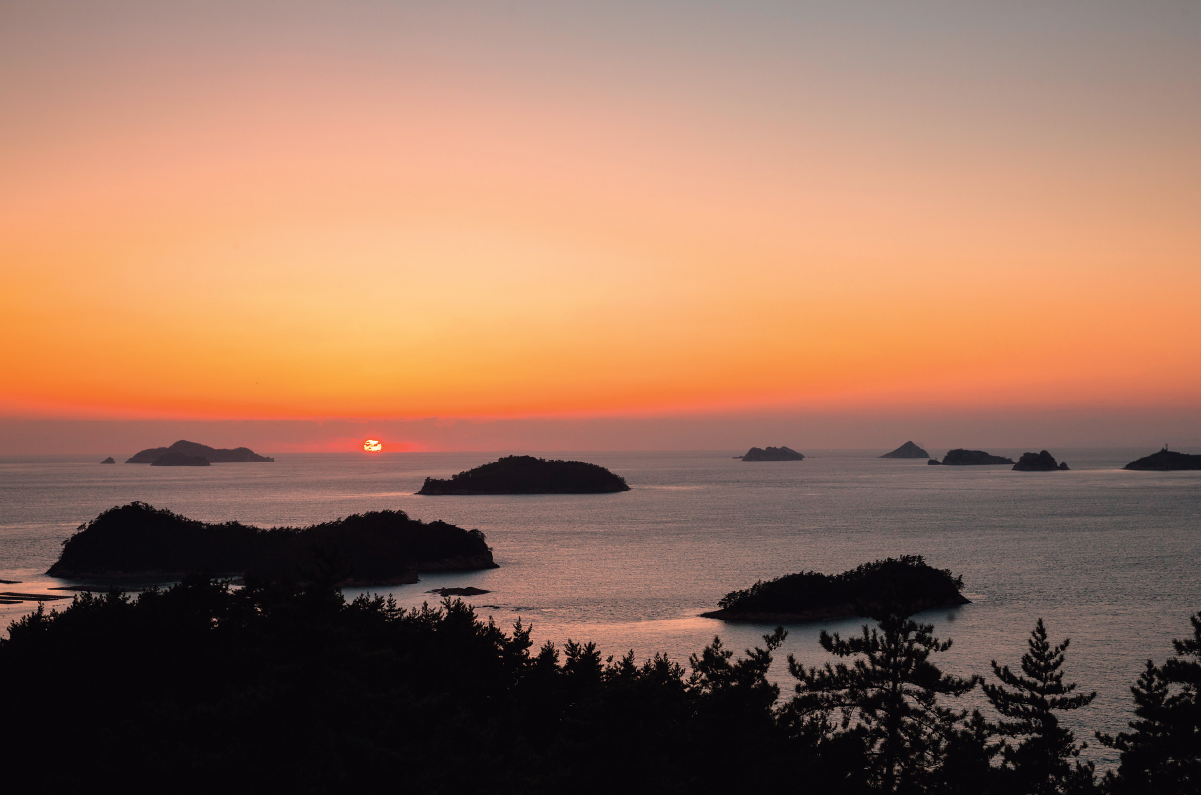
Sebang Nakjo is located at the southernmost end of Korea. Creating splendid evening twilight scenery, the 154 islets turn into black silhouettes when the sun sets.
While Jindo missed the possibility of robust trade and commerce,
it did become a crucible for foreign and native elements to intertwine
and flourish. But Jindo’s location also lent itself to become
a famous place of bloodshed and despair.
Exiles’ Lasting Input
Amid the plentiful harvests and joyous singing, there are thick strata of sorrow and anguish in Jindo’s history, too. The distance from the capital made the island a perfect place to confine scholar-officials who fell out of favor for political or ideological reasons. To them, Jindo was a faraway place to rot and be forgotten. But the capital’s discards became Jindo’s blessing.
As the banished scholar-officials spent three to 20 years in exile on the island, they inevitably mingled with natives, introducing the culture of different regions and transmitting the spirit and value of the times to talented minds. Consequently, Jindo’s culture became far more diversified and enriched than most other areas of Korea.
For example, Jindo is recognized today as the center of the Southern School of literati painting and this year, it hosted the first Jeonnam International Sumuk Biennale (sumuk is the Korean word for ink painting; Jeonnam refers to South Jeolla Province).
This can be traced to two Jindo natives, Heo Ryeon (1809–1892) and Heo Baek-ryeon (1891–1977), who rank among Korea’s most eminent Southern School painters.
They were taught and supported by exiles who brought with them a deep knowledge and appreciation of art from the capital. In the same context, a culture of homebrewing developed. The drinks include hongju (literally “red liquor”), made by steeping the dried roots of a herb called jicho (purple gromwell) in rice liquor during the distillation process to turn the liquor red, and tea made with the young shoots of tea plants found in the mountains and fields throughout the island.
Military Turning Points
During the Joseon Dynasty (1392–1910), the shortest way to Jindo was by boat from the Right Naval Command Base in Haenam to Nokjin Port. However, the strong currents around the island persuaded ordinary people to use a longer one-kilometer route and embark from Byeokpa Port. Over the hill from the port is the site of the old Yongjang Mountain Fortress. This was the headquarters of the Sambyeolcho (Three Elite Units), which opposed the Goryeo government’s decision to submit to the Mongols who invaded in 1231. The units rebelled and retreated to Jindo, where they dreamed of creating “a new Goryeo” and battled the Mongols until the end.
Jindo was an ideal location for defense. After arriving in the latter half of 1270, the Sambyeolcho turned Yongjang town’s defensive infrastructure into a fort and began building a proper military fortress around Yongjangsa, the island’s largest Buddhist temple. While using the name of Goryeo, they seated their own king and built an almost exact replica of Manwoldae, the Goryeo royal palace in the capital Gaegyeong (today’s Kaesong in North Korea) as their headquarters.
The people of Jindo supported the goals of the Sambyeolcho and lent assistance. They, too, wished to be free of the Mongols, who had exceeded previous invaders in the amount of territory seized. But the resistance did not last long. Less than a year later, Yongjang Mountain Fortress fell under the united Mongol- Goryeo forces, ending the war in 1271.
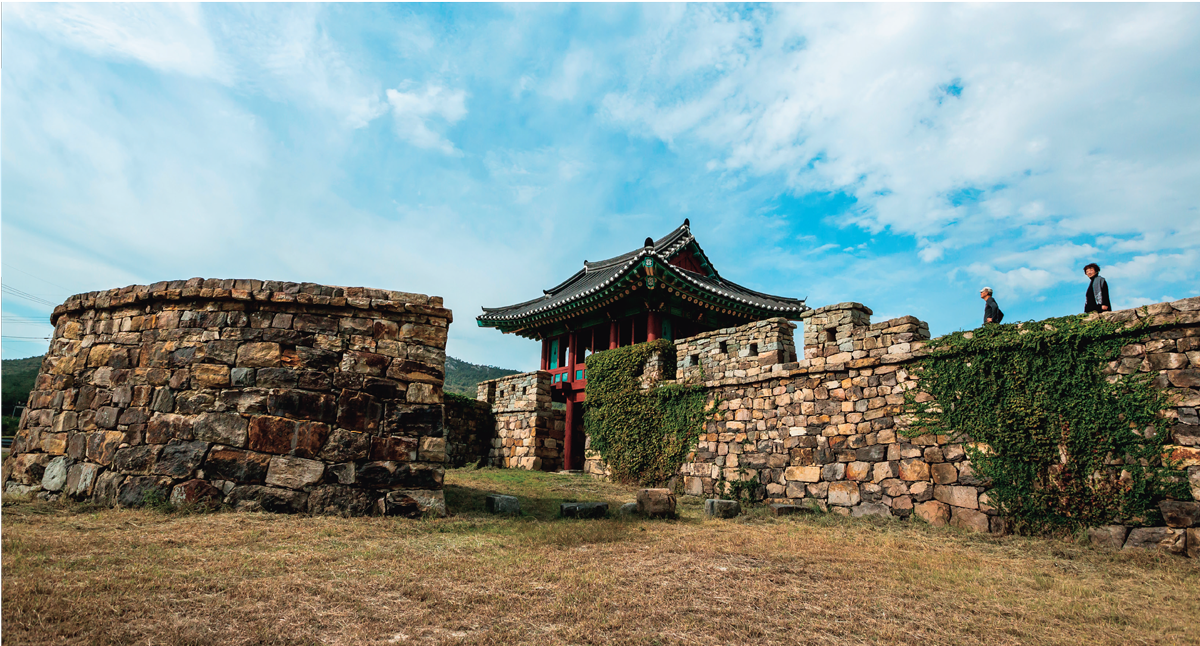
The Namdo Garrison Fortress, or Namdo Jinseong, was erected in the 13th century to defend the coastal region when the Sambyeolcho, the “elite troops” of Goryeo, fought Mongol invaders. During the succeeding Joseon Dynasty, it was used as a naval fort to block Japanese invaders.
How did Jindo natives feel at the sight of their island home so quickly transformed into a hellish battleground? One spot on the island gives some clues. To this day, the islanders conduct memorial rites on the first full moon day of the year at a shrine dedicated to Bae Jung-son, leader of the Sambyeolcho. At this point, historians like to remind us of an incident in which the Sambyeolcho burned identification papers indicating an individual’s social class before they headed to Jindo. In the strictly class-based society of Goryeo, they opposed the existing order and dreamed of a new, democratic nation. After defeating the Sambyeolcho, the Mongols took some 10,000 Jindo locals as prisoners of war and established a horse ranch on the island. This lends credibility to the theory that the beloved Jindo dog, an official “national treasure,” is a descendant of a sheep dog brought in by the Mongols and a native breed.
Byeokpa Port came under attention again some 300 years later during the second Japanese Invasion (1597–98), known as Jeongyu Jaeran. Admiral Yi Sun-sin, who had been demoted amid fractious political infighting, was reinstated as supreme naval commander to stop a Japanese fleet sent to support the invading troops of Toyotomi Hideyoshi. But he was only able to muster 12 warships as the Korean navy had been decimated in a series of battles against Japan while he was dismissed and incarcerated.
Yi kept hundreds of Japanese warships at bay and then a last stand ensued in the Myeongnyang Strait, or “Screaming Strait,” between the Nokjin and Byeokpa ports. On October 26, 1597, Yi masterfully utilized the fast-moving tides and whirlpools of the strait, which is some 200 meters wide at its narrowest point. The extreme difficulty in navigating the rapid currents neutralized the Japanese fleet’s huge advantage. It lost scores of ships and withdrew in defeat.
Yi’s stunning victory is remembered by many as a brilliant display of military strategy that enabled a vastly outnumbered force to prevail. Often overlooked are Jindo natives. Following Yi’s instructions, they lined both sides of the strait and barraged the Japanese with rocks and arrows.
When the admiral left for the west coast to reorganize his forces, the Japanese took cruel revenge on the Jindo locals. Returning to the island 23 days later, Yi found total destruction. In his war diary, “Nanjung Ilgi,” he wrote, “Not a single house was left standing. The whole countryside was silent with no trace of human life.” The consequences for Jindo were horrific but the humiliating defeat of the Japanese in the Myeongnyang Strait reversed the tide of the war and ended seven years of fighting. Today, statues of Yi stand in Nokjin and at Gwanghwamun Square in the heart of Seoul.
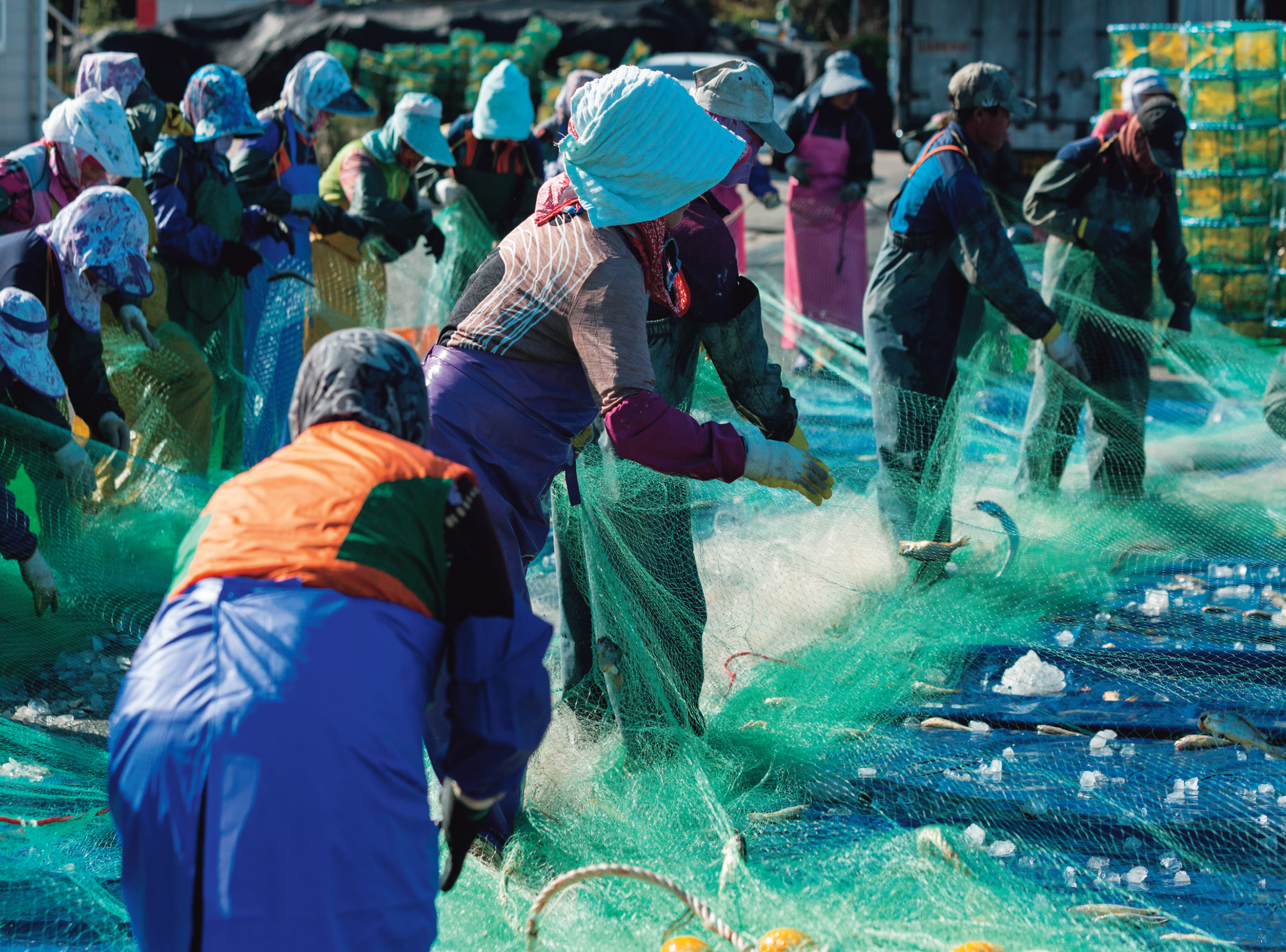
Women hurriedly shake croaker from fishing nets at Seomang Harbor. The fish must be quickly removed from the nets and frozen to maintain their freshness. So during croaker season, villagers converge creating a grand spectacle of collective effort.
Two Graveyards
On the roadside at the foot of the mountain in Dopyeong Village, some way inland from Byeokpa Port, there is a cluster of around 230 graves. The official name is Graveyard for War Dead of the Second Japanese Invasion. Here lie the Joseon soldiers who died in the Battle of Myeongnyang and the common people who were killed in revenge by the Japanese. Aside from 10, most are the graves of the unknown dead. All of them face north toward the king in the capital.
Following the mountain road running toward the sea for some nine kilometers, there is a pretty, low hillside named Waedeoksan. Another 100 graves were once located here — those of Japanese soldiers who fought in the same battle under the command of the warlord Kurushima Michifusa. When the bodies of the Japanese were washed ashore, the villagers retrieved them and buried them on the hillside facing south toward Japan. Because of road construction and land reclamation, many of the graves were damaged and only around 50 remain today.
In August 2006, when the news of the graveyard first became known in Japan, the descendants of the dead and a group of university students came to Jindo and visited the site under the guidance of the villagers. A Hiroshima newspaper reported on the visit, calling the graveyard a sacred place and expressing gratitude to the Jindo people. But for the islanders, such compassion was only natural, considering that the traditional Korean view of life and death places importance on reconciliation between the living and the dead. This is also reflected in ssitgim-gut, a shaman funeral rite of Jindo held to resolve the grudges of the dead and cleanse their souls so that they may find peace.
The Living and the Dead
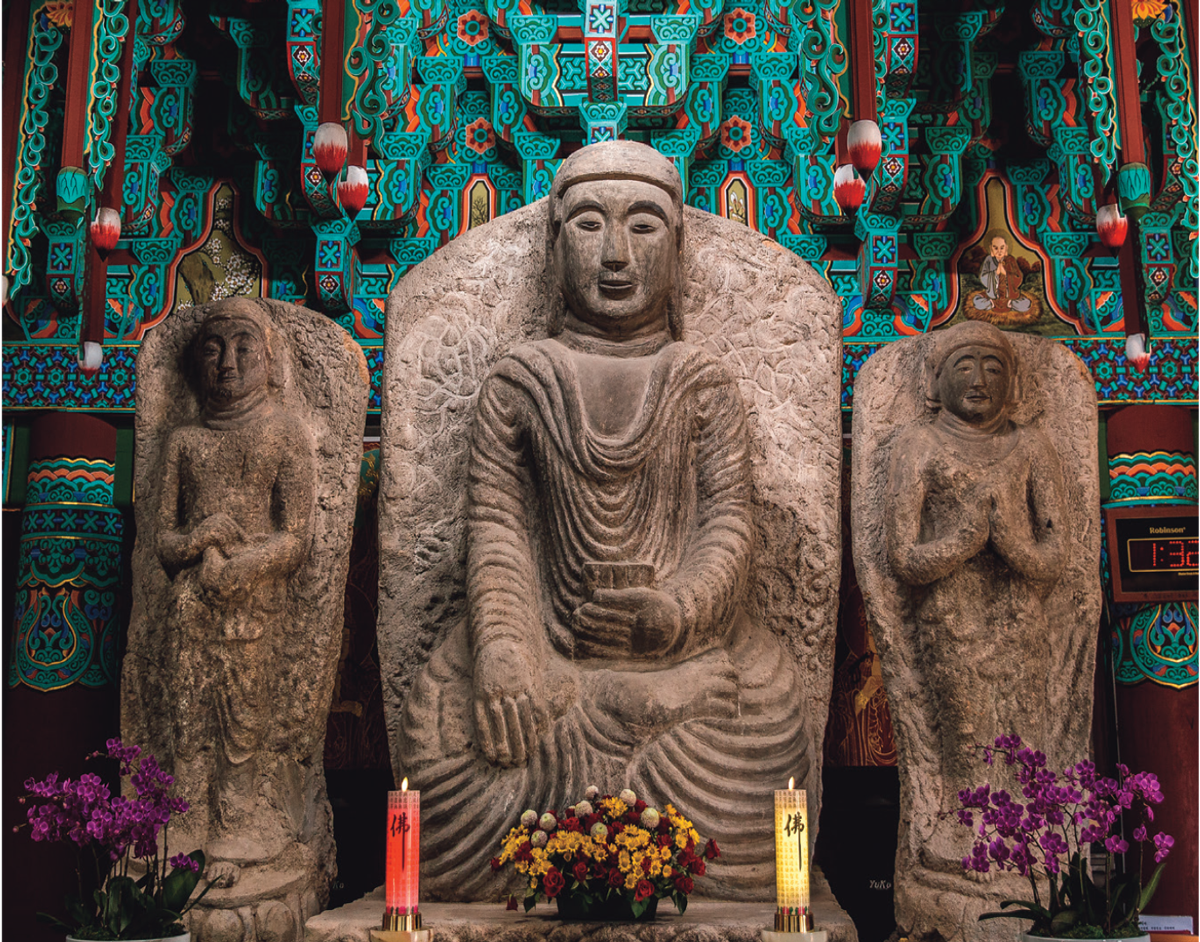
The stone Buddha triad at Yongjang Temple has a 2-meter-high Medicine Buddha at the center. Seated on a lotus pedestal, its lower body is high and large, showing a proportion typical of Goreyo Buddhist images.
In the context of Western religion, the word ssitgim would be akin to baptism; indeed, the religious theories behind the two ceremonies are not entirely different. However, the “soul cleansing rite” of Jindo changes in name and nature according to the place or cause of death; the procedures and narrative are subject to circumstances. For example, when salvaging the soul of a person who drowned to death, the rite is called “geonjigi (to pick up from the water) ssitgim-gut,” and when appeasing the soul of one who died away from home and is thus a lonely spirit, the rite is called “honmaji (meeting the soul) ssitgim-gut.” Moreover, the rite is distinguished from the shaman funeral rites of other regions for its artistic elements. Thanks to its simple yet alluring “dance for the gods,” narrative conveyed through song, and various shaman implements, the Jindo ssitgim-gut is more than just a religious ceremony. It holds state recognition as an Important Intangible Cultural Property.
Lurking in the depths of desire to find reconciliation between the living and the dead are painful memories of the past. The people of Jindo have suffered the fetters of history arising from events such as the Donghak Peasant Movement of 1894–95 and the Korean War of
1950–53, time and again witnessing the unjust massacres of its people. For them, the sinking of the Sewol Ferry in the waters off Jindo in 2014, leading to the death of 250 high-school students and 54 teachers, crew members and others, was all the more heartbreaking and sorrowful. Such it is that all deaths are private and yet public at the same time.
On this note, the French anthropologist and ethnologist Claude Lévi-Strauss wrote: “They have been no more successful than other societies in denying the truth that the image a society evolves of the relationship between the living and the dead is, in the final analysis, an attempt, on the level of religious thought, to conceal, embellish or justify the actual relationships which prevail among the living.” (“The Sad Tropics” by Claude Lévi-Strauss, translated by John and Doreen Weightman, Penguin Books, p. 246)
Perhaps it is natural that Jindo has been able to retain its special culture of healing.